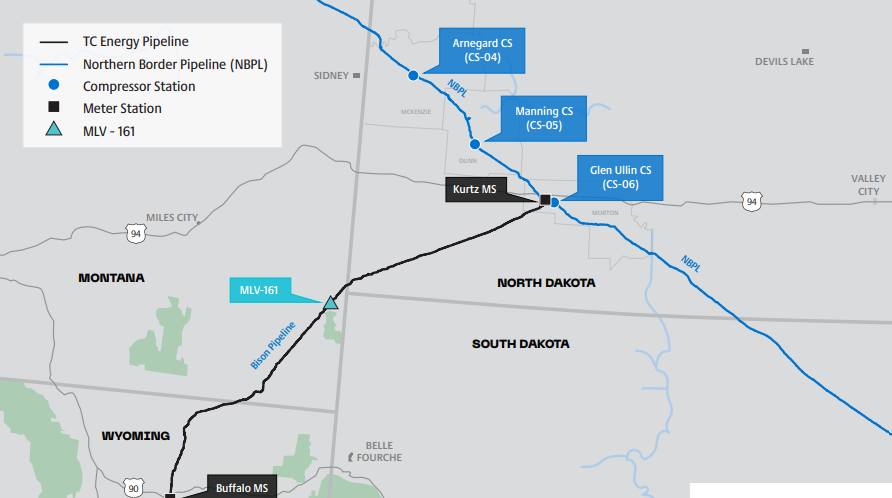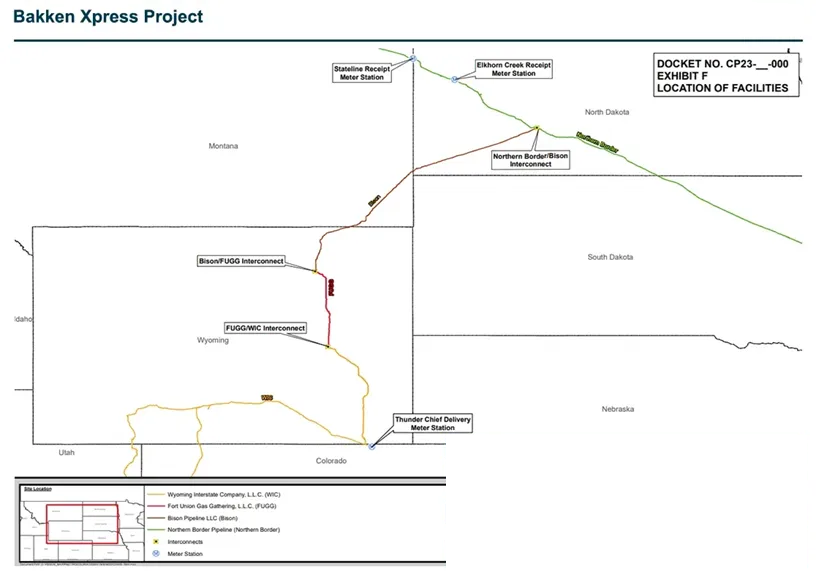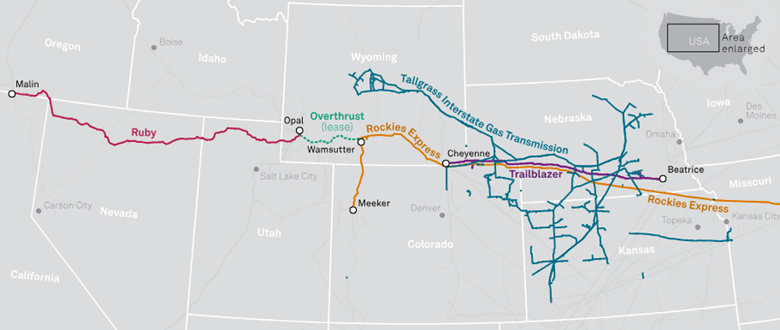Looking for something specific? Jump to a section:
Commentary Outlook & Notes Market-Relevant Events Infrastructure Supply Chart Pack
Wild swings in weather forecasts in the first two weeks of December have resulted in volatile natural gas prices. Regional basis pricing has lost ground since the beginning of the month as weather models shifted warmer. This is despite a stronger than normal withdrawal from regional storage for the first week of December. Storage fell to 277 Bcf in the Mountain region for the week ending December 5, below the high end of the five-year range but still 20% higher than the five-year average. Production has consistenly remained above 8.2 Bcf/d for the past four weeks, up roughly 0.3 Bcf/d year over year. November and December demand has so far been in line with 2024 levels. Winter months typically provide opportunities to hedge as yearly demand peaks.
December 12: Rocky Mountain basis pricing has been under consistent selling pressure for the past month. Front month CIG basis (Jan26) has fallen from $0.385 as of the close on November 12 to -$0.320 intraday on Friday December 12. Similarly, Jan 26 NWP Rockies basis has sold off from $0.7775 as of the close on November 12 to -$0.185 intraday Friday December 12. Surprisingly, Summer 26 (Apr26-Oct26) hasnt been as negatively affected as the front month tenors or Winter 26/27 (Nov26-Mar27).
November 17: Prompt month pricing looks much stronger from the start of the month, but this is likely due to the contract rolling to Dec25 rather than a structural shift in underlying fundamentals. Since its first day trading as the prompt contract (November 3) the Dec25 CIG basis price has risen to $0.1145 intraday November 17 from $0.03. The contract hit as high as $0.255 on November 14 following six days of buying. Basis pricing at NWP Rockies has fallen since the start of the month with the Dec25 basis swap down to $0.380 intraday November 17 from $0.4795 at the open on November 3. The Summer26 contract for both CIG basis and NWP Rockies basis have come under selling pressure the past few trading days leading to price declines of roughly $0.03 each.
October 20: The November CIG basis price continues to see volatility as the contract trades back near its monthly low. There have been major swings in price over the past month as heavy selling pressure gave way to a string of strong buys. However, sellers have once again returned, pushing price back down to -$0.685 intraday on October 20. The trading pattern seen in the prompt month contract has also carried into 2026 as both the Winter 25/26 and Summer 26 strips have followed the same pattern. The Summer 26 strip is currently trading -$0.8495 intraday on October 20, down $0.11 from a month ago. NWP Rockies basis continues to hold a slight premium to CIG with the November contract trading down to -$0.430 and Summer 26 down to -$0.680.
October 2: Rockies basis pricing has come under heavy selling pressure the past seven trading days. The newly prompt November CIG contract is down 55%, falling from -$0.4175 at the open on September 24 to -$0.65 intraday October 2. Over the same period, NWP Rockies basis pricing for November is down from -$0.085 to -$0.4115. Falling basis pricing is not constrained just to the prompt month as Winter 25/26 and Summer 26 are down across both CIG and NWP Rockies.
September 12: Regional basis pricing has been stable for the past month as higher demand has matched increased supply. As a result, regional storage levels have only increased 4 Bcf since the first full week of August. The Oct25 CIG basis contract has risen $0.246 since August 1 to trade -$0.5835 intraday on September 12. Over the same period the Oct25 NWP Rockies basis contract is up $0.28 to trade -$0.41 intraday on September 12. Forward strips, Nov25-Mar26 (Winter) and Apr26-Oct26 (Summer), have been relatively stable following heavy selling on August 5 and 6. Basis pricing at CIG is currently trading -$0.055 for Winter 25/26 and -$0.75 for Summer26. NWP Rockies basis is trading $0.38 during Winter 25/26 and -$0.53 for Summer26.
August 15: Basis pricing at CIG has remained steady over the past month with little movement throughout the forward curve. Between July 15 and August 15, the Winter 25/26 strip has fallen $0.0225 from -$0.0325 to -$0.055 but traded as high as $0.0375 and as low as -$0.08. It's a similar story for the Summer 26 strip with pricing down $0.0253 from -$0.7547 on July 15 to -$0.78 on August 15. However, West Coast price declines have brought NWP Rockies basis pricing down over the past 30 days. Currently Winter 25/26 basis is down $0.135 over the past month to $0.4298 with much of that drop coinciding wtih selling pressure in the middle of last week. Summer 26 has also fallen but to a lesser degree, only losing $0.065 over the past month to trade -$0.55.
August 1: Basis prices across the Rockies have been stable for the past two weeks. The now prompt September CIG basis contract is down 6.5c from -$0.695 on 7/21 to -$0.76 intrady on 8/1. Over the same two weeks, the Nov25-Mar26 strip has gained 2.5c moving from -$0.03 to -$0.005. It's a similar story throughout the forward curve with most months between Nov25-Jan28 gaining slightly over the past 10 trading days. NWP Rockies' basis has also traded sideways in the past two weeks. The front of the curve, through Dec25, is a touch lower while the remainder of the forward curve is flat.
July 18: Basis forward curves have traded sideways for the first half of the month. The August CIG basis price opened trading on July 1 at -$0.6175 and currently at -$0.580 intraday on July 18. It's a similar pattern down the basis curve as Winter 25/26 and Summer 26 are down $0.045 and $0.02 respectively since the start of July. NWP Rockies basis has been a bit more volatile with the August contract trading as high as -$0.2225 intraday on July 9 but falling to -$0.40 as of July 18. A rebound in Henry Hub pricing and regional production near seasonal highs could put some short term pressure on basis pricing.
July 7: Persistent heat across the West Coast and Rockies has led to a rapid strengthening of prompt month basis pricing. Forecasts remain warm for the remainder of the month with July expected to be warmer than normal. In the past two weeks, the prompt month August CIG basis price has rallied from -$0.83 on 6/23 to -$0.5175 intraday 7/7. With price trading inside -$0.55, this is the best price for the August contract since January. The move also continues throughout what remains of the summer strip with the October basis contract rising from -$1.045 on 6/23 to trade -$0.74 as of the close on 7/3. NWP Rockies basis has also strengthened, with the August contract rallying from -$0.56 on 6/23 to -$0.36 intraday 7/7.
Price action will continue to be heavily weather driven and influenced by adjacent regions as the Rockies looks to push gas out during the summer and meet regional demand during winter. No significant changes to pipeline egress capacity are expected over the next few years. However, there will be small increases in pipeline capacity from a few pipeline expansions throughout late 2025 and early 2026.
CIG Rockies & NWP Rockies Basis Outlook and Notes
|
Winter '25-'26
Cold winter weather across the West Coast and Rockies provide low probability but highly impactful upside potential
Williams' expects its 325 MMcf/d expansion of MountainWest Overthrust Pipeline to be online in 4Q25. The additional capacity will allow more eastern Rockies gas to flow to premium western markets
|
Summer '26
Shoulder seasons (spring/fall) look particularly susceptible to low prices as demand evaporates, and production expectations remain robust
De-risk on strength, particularly on early November 2025 or December 2025 cold spells which should help lift the forward curve
Additional supply coming from the Bakken into Cheyenne/CIG could pose additional pressure in 2026 as the Bakken Xpress project is scheduled to be completed in March 2026
|
Winter '26-'27
Basis pricing during Winter will remain susceptible to price appreciation should sustained cold materialize for the West Coast, Rockies, or Midwest regions although supply remains robust
Take advantage of basis prices that are a premium to Henry Hub to de-risk the portfolio
|
|
|
For more discussion on basis price moves and the current forward curves:
For more discussion and charts, jump to our outlook and chart pack. Remember, the local market is influenced by the broader gas market. Consult our Gas Macro Outlook for more.
|
Recent Market-Relevant Events
7.24.2025
Tallgrass to partner with Crusoe to power AI datacenter in southeast Wyoming
|
6.24.2025
Canadian exports to Rockies/PacNW hit low as LNG Canada ramps up
|
6.14.2025
Tallgrass secures anchor shippers for new pipeline
|
|
|
A lack of production growth since 2020 has meant pipeline egress capacity has not been challenged by production. However, there are limitations and constraints within the basin to move gas from east to west from CIG/Cheyenne to NWP Rockies/OPAL. Expectations are the basin will continue to have available egress out of each major corridor. A few in basin pipeline projects will also help move natural gas intrabasin.

|
For a discussion of production outlook:
Below are the most market-relevant infrastructure projects that appear to be funded and going forward. The projects that offer intra-region capacity (egress) are also shown in the chart above.
Note: Deeper discussion included below the map.
|
Major Pipeline Corridors Out of The Rockies
Gas Pipeline Flows
Gas Pipeline Projects
MountainWest Overthrust Westbound Expansion
In-service date: 4Q25
Capacity: 0.3 Bcf/d
|

Source: Williams
|
|
MountainWest Overthrust Expansion - Construction on Williams' MountainWest Overthrust expansion is ongoing. According to the companies latest maintenance schedule, commissioning should take place November 6-8.
|
Bison Xpress
In-service date: March 2026
Capacity: 0.3 Bcf/d
|

Source: TC Energy
|
|
|
Bison Xpress - TC Energy is working to increase capacity on the Northern Border Pipeline (NBPL) system by replacing three existing compression stations. The increased capacity of 300 MMcf/d will be leased by Wyoming Interstate Company as part of its Bakken Xpress Project. In addition, the project would allow bidirectional natural gas flow on TC's Bison pipeline.
|
Bakken Xpress
In-service date: March 2026
Capacity: 0.3 Bcf/d
|

Source: NGI, Kinder Morgan
|
|
|
Bakken Xpress - Kinder Morgan's connection to the Bison Xpress project, which will provide egress south from Bison pipeline to Cheyenne via the Fort Union Gas Gathering system and Wyoming Interstate Pipeline.
|
Tallgrass Permian-to-REX Pipeline
In-service date: late 2028
Capacity: 2.4 Bcf/d
|

Source: S&P, Tallgrass
|
|
|
Tallgrass Permian-to-REX Pipeline - Tallgrass Energy plans to build a 2.4 Bcf/d greenfield pipeline linking the Permian Basin to the Rockies Express Pipeline (REX), targeting a late 2028 in-service date. The project has secured anchor shipper agreements, enabling it to move forward pending regulatory and corporate approval. The pipeline will enhance access to Midwest and Plains markets via REX and Tallgrass Interstate Gas Transmission (TIGT), with optional flows westward through Ruby and Overthrust.
|
REX/Cheyenne Connector Enhancement
In-service date: 2Q28
Capacity: 0.25 Bcf/d
|
 |
|
| REX/Cheyenne Connector Enhancement - Rockies Express, Cheyenne Connector and East Cheyenne Gas Storage jointly filed an application to FERC requesting authorization for Rex to lease 250,000 Dt/d capacity on Cheyenne Connector and build a new 153 mile 24" pipeline to Colorado Springs. The application submitted on August 15 is the latest in a series of announcements by Tallgrass to enhance its ability to meet local demand in the Rockies. |
Local Supply
|
Supply has been resilient throughout 2024 and 2025 even as the rig count in the region has stabilized around 40, well below 2022 (50) and 2023 (49) averages. Production within the basin has been on a downtrent the past decade, bottoming in Spring 2023 but has climbed slightly since. Expectations are natural gas supply in the Rockies will remain flat for the next few years.
|
|
Operator Guidance
Civitas Resources (Q3 2025 EC)
|
11/06/2025
|
|
2025 Guidance:
Announced merger with SM Energy while also selling two non core DJ Basin packages during the third quarter
Key Basin Activity:
DJ production increased six percent quarter over quarter to 155 MBoe/d (46% crude oil)
Activity in the basin included 31 wells drilled, 28 wells completed and 40 wells turned to sales
Due to pending merger with SM Energy, no new guidance was provided
|
|
Williams (Q3 2025 EC)
|
11/04/2025
|
|
2025 Guidance:
Adjusted EBITDA guidance reamains unchanged at $7.75 billion midpoint
Key Basin Activity:
Completed and placed into service Northwest pipeline Stanfield South expansion
New open season announced during 3Q25 for 64,000 Dth/d of additional capacity on MountainWest Overthurst pipeline from Opal Processing Plan and Pioneer Processing Plan to a future lateral and Green River West Tap
Continue to see strong demand growth in Rockies/Northwest due to industrial expansions, mining and power reliability concerns
|
|
EOG (Q3 2025 EC)
|
11/07/2025
|
|
2025 Guidance:
Full year 2025 free cashflow estimates raised to $4.5 billion, up $200 million from prior guidance
Key Basin Activity:
Powder River Basin (PRB) was cited as an "emerging" play, making "tremendous progress on improving well performance and lowering costs"
Not expecting to materially increase production in 2025
|
|
Occidental Petroleum (Q3 2025 EC)
|
11/11/2025
|
|
2025 Guidance:
Slightly increased production guidance to 1,440-1,480 MBoe/d
Key Basin Activity:
Rockies well performance increased 14 MBoe/d compared to midpoint of guidance
Continue to guide Rockies & Other production in the 271-277 MBoe/d
Activity remains two rigs and one frac crew
Don't expect to increase capital into Rockies but may shift allocation of resources between DJ and Powder River Basin
|
|
|
Local Demand
|
Demand in the Rockies varies wildly between Winter and Summer. Winter demand averages roughly 3.5 Bcf/d compared to 1.5 Bcf/d across the Summer. However, the overall demand has been steady the past five years with no expectations for a shift in those dynamics. The basin will continue to rely on moving gas out of the region, supplying the West Coast, Midwest and Midcontinent.
|
|
Recent Market-Relevant events
|
Tallgrass partners with Crusoe to power AI Datacenter in southeast Wyoming
(July 24, 2025)
Market Impact: On its surface, additional regional demand should benefit regional basis pricing
-
Tallgrass and Crusoe have announced a partnership to develp a 1.8 gigawatt (GW) datacenter in Southeast Wyoming
-
The datacenter will "leverage diverse power strategy...fueled by natural gas and reneweable energy"
-
Initial plans are the 1.8 GW datacenter will be scalable to 10 GW of capacity over time
|
|
Canadian Gas Exports to Rockies/PacNW Hit 2025 Low as LNG Canada Starts Production
(June 24, 2025)
Market Impact: Lower natural gas imports from Canada should support western US basis pricing moving forward
-
Canadian natural gas exports to the Rockies/PacNW fell to 3.48 Bcf/d in June, the lowest monthly average of 2025 and 0.74 Bcf/d below January levels, amid soft Pacific Northwest demand and rising domestic competition
-
The start of production at LNG Canada Phase 1 (targeting ~2 Bcf/d) is emerging as a new structural factor reducing westbound export flows, as Canadian supply increasingly stays north to serve LNG demand
-
The declining exports, paired with LNG Canada's ramp-up, signal increased Canadian gas competition in western North American markets and point to higher price volatility ahead, especially into winter
|
Tallgrass Secures Anchor Shippers for New Permian-to-REX Pipeline Targeting Late 2028 Start
(June 14, 2025)
Market Impact: This should weigh on CIG pricing later in the decade as Permian gas further supplies the Rockies and adjacent demand markets
-
Tallgrass has signed anchor shipper precedent agreements to support the construction of a pipeline from the Permian Basin to the Rockies Express Pipeline (REX), unlocking up to 2.4 Bcf/d of new natural gas takeaway capacity
-
These commitments provide financial justification for project buildout, targeting in-service by late 2028, contingent on final regulatory and corporate approvals
-
The pipeline will provide access to REX's east-west backbone, linking Permian gas to Midwest, Rockies, and Northeast markets
-
The project could help alleviate future Permian gas bottlenecks, improve basis differentials, and support AI-driven power demand and reshoring -related industrial growth across multiple U.S. regions
|
Williams MountainWest Overthrust Expansion Underway, In-Service by 4Q 2025
(March 03, 2025)
Market impact: Price spreads between CIG and NWP Rockies should tighten as additional gas moves west across the basin
-
Williams began construction on its MountainWest Overthrust expansion in April 2025, with 4Q 2025 targeted for in-service, per maintenance schedule
-
The expansion will add 325 MMcf/d of new westbound capacity to the Opal hub (Wyoming), bolstering east to west natural gas flows in the Rockies
-
The construction schedule includes multiple compression upgrades and station outages spanning April to October, with some segments experiencing 100% nomination cuts during work windows
-
Once complete, the project should tighten regional price spreads and position Williams to capture stronger western flows amid Canadian competition and renewables intermittency
|
|
|

Don’t stop here.
See how other regions are performing right now:
|